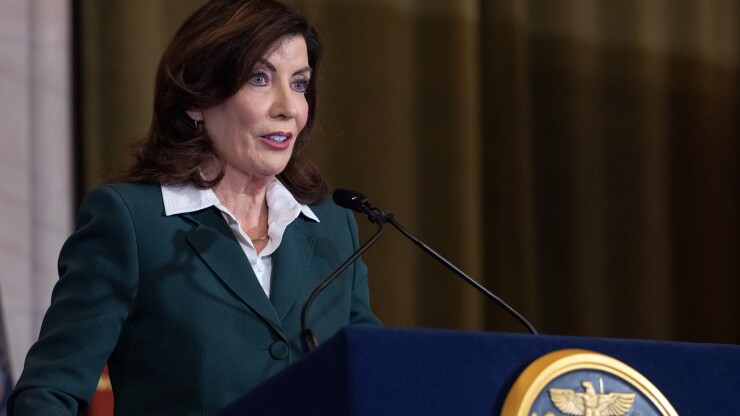New York’s governor ordered the MTA to kill congestion pricing. What now?
7 min read

The New York Metropolitan Transit Authority had installed the toll gantries. It had finalized the environmental reviews. It had budgeted $15 billion of capital projects counting on revenues from congestion pricing.
But New York Gov. Kathy Hochul proved Wednesday that congestion pricing still wasn’t safe.
Hochul directed the MTA to halt congestion pricing and asked the legislature to find another $1 billion for the MTA’s budget. The MTA’s capital projects remain paused. It’s unclear whether Hochul’s “indefinite pause” will go the way she intended, or even what her intentions were.
Office of Gov. Kathy Hochul/Mike Groll
Congestion pricing — tolls on drivers entering Manhattan’s central business district — was supposed to take effect on June 30. It would have yielded an annual $1 billion in revenue, a stream that was expected to support up to $15 billion in debt for the MTA’s capital programs.
The MTA already knew congestion pricing was under threat from eight different
But Hochul’s abrupt announcement came out of nowhere.
Hochul had vocally supported congestion pricing as recently as
Kathryn Wylde, the CEO of Partnership for New York City and a member of the Traffic Mobility Review Board that designed the congestion pricing program, said Hochul assured her in a conversation on Wednesday that the pause would be temporary, but would not specify a date when it would come back.
The authority to cancel congestion pricing lies with the MTA board and the New York state legislature, according to Rachael Fauss, a senior policy advisor for Reinvent Albany.
The legislature might need to repeal its 2019 bill authorizing congestion pricing, since the bill said the MTA “shall” implement the tolls, Fauss said.
The MTA board must vote to stop the tolls from taking effect at their June 26 board meeting. The governor directly appointed the chairman of the board, Janno Lieber, and a plurality of its members. These members are likely to follow the governor’s instructions, Fauss said.
The MTA’s lawyers alerted the judge overseeing several congestion pricing lawsuits that it no longer plans to begin tolls on June 30. However, some board members have
“They have an oath that they have to sign as board members to uphold the fiduciary interests of the agency,” Fauss said. “And I think if they vote to defund themselves of $15 billion for the capital plan, they are opening themselves up to lawsuits.”

Bloomberg News
Hochul asked the legislature to create an alternative funding plan: a $1 billion annual increase to the payroll mobility tax. This plan went over poorly, and the current plan, Bloomberg News reported, is to pass a bill that guarantees the MTA will have $1 billion per year without specifying the funding source.
The state just
One impediment to Hochul’s efforts is that her announcement came with only two days left in the legislative session. The legislature extended its session into the weekend, but that still leaves little time for dealmaking. Besides, that’s far from the only problem.
The MTA already derives 44% of its revenue from taxes, compared to only 13% from tolls, Wylde noted. This imbalance, she argued, makes any tax hike less favorable than congestion pricing.
And, although Hochul cited concern for the economy and local businesses as the basis for canceling congestion pricing, raising an extra $1 billion in taxes could certainly have economic ramifications, according to Howard Cure, director of municipal research at Evercore.
“Businesses and people don’t move to New York because it’s a tax haven,” Cure said, “but there comes a point — and I’m not sure what that breaking point is — where you can’t put too much of a burden on the taxpayers.”
If the legislature can’t pass a bill, Hochul might want to use the state’s reserves, Fitch analyst Tammy Gamerman said. But such a one-time reserve payment can’t support $15 billion of debt.
None of the proposed solutions can replace the other goals of congestion pricing: lowering pollution and congestion and increasing MTA ridership.
“Excess traffic congestion costs the city over $20 billion a year. And that’s a combination of lost productivity, increased fuel costs, and impacts on the environment and health,” Wylde said. Congestion “in general has been very expensive, far more expensive than the congestion pricing tool.”
If the legislature can’t find an alternative source of funding, the MTA could have a
If the next capital plan involves similar amounts of debt as the current one, MTA’s debt service costs will be 51% higher in 2037 than in 2023, the report said. But if the MTA can’t replace congestion pricing revenue and covers half its budget gap with bonds, debt service would be 84% higher in 2037 than in 2023. That’s the equivalent of raising the subway fare by 13%.
The MTA already
The
The elevator projects were part of a
Joseph Rappaport, executive director of the Brooklyn Center for Independence of the Disabled, a plaintiff in the lawsuits, said the loss of any funding for the MTA is a setback for disabled people.
“What we fear is that this will drag on for months, if not years,” Rappaport said. “And it will have a real-world effect on the ability of disabled people and everybody else to get around.”
The governor
“She has to come up with another source of funding, and quickly. And if she doesn’t, then that calls into question her commitment to accessibility in the subways and in New York,” Rappaport said. “The governor suggested one, right? Increasing business tax. But, you know. Okay, fine. Get it done.”
In the past, the MTA has been able to rely on the state for revenue, Fitch analyst Michael Rinaldi said. New York has been much more supportive of the MTA than other states have been to their public transportation systems; passing congestion pricing in the first place is evidence of its support.
If Hochul’s announcement signals a change in the state’s pattern of support, it could change how Fitch evaluates the MTA’s creditworthiness and governance, Rinaldi said. He is paying close attention to what the legislature passes.
Fitch rates the MTA’s transportation revenue bonds AA after
Hochul’s flip-flop on congestion pricing may damage her credibility and influence within the legislature, Cure said.
New York Democrats lost several congressional seats in the midterm elections, and it’s possible Hochul thought congestion pricing would hurt the party’s chances in suburban seats in 2024.
If Hochul really did delay congestion pricing on political grounds, the “indefinite pause” may mean a pause until late November — especially if the legislature won’t create a new tax.
That’s a dangerous bet, Cure said. If Biden loses reelection, the MTA would have to contend with the Trump administration, which was hostile to congestion pricing in the former president’s first term.
However the MTA gets its revenue, Hochul’s decision comes with a cost, Fauss said.
“An immense amount of staff time and preparation went into the environmental assessment, the public education,” Fauss said. “Depending on how indefinite this pause is, it’s just a massive waste of MTA staff resources, time, literal infrastructure costs for the gantries, and then just demoralizing for the MTA staff.”
And all the toll gantries and license plate cameras the MTA erected around the central business district?
“They sit there,” Fauss said, “and







